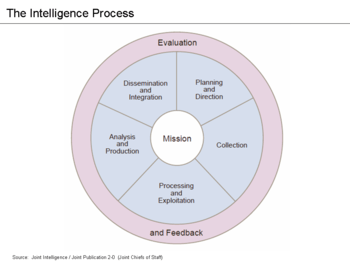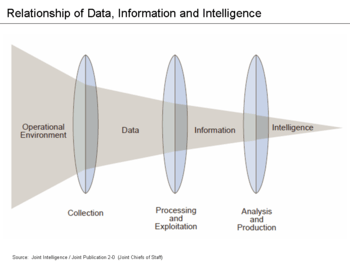Intelligence cycle
The traditional Intelligence cycle is the fundamental cycle of intelligence processing in a civilian or military intelligence agency or in law enforcement as a closed path consisting of repeating nodes. The stages of the intelligence cycle include the issuance of requirements by decision makers, collection, processing, analysis, and publication of intelligence.[1] The circuit is completed when decision makers provide feedback and revised requirements. The intelligence cycle is also called the Intelligence Process by the U.S. Department of Defense (DoD) and the uniformed services.[2] The intelligence cycle is an effective way of processing information and turning it into relevant and actionable intelligence.
Conceptual model


Direction
Intelligence requirements are determined by a decision maker to meet his/her objectives. In the federal government of the United States, requirements can be issued from the White House or the Congress. In NATO, a commander uses requirements (sometimes called Essential elements of information (EEIs)) to initiate the intelligence cycle.
Collection
In response to requirements, an intelligence staff develops an intelligence collection plan applying available sources and methods and seeking intelligence from other agencies. Collection includes inputs from several intelligence gathering disciplines, such as HUMINT (human intelligence), IMINT (imagery intelligence), ELINT (electronic intelligence), SIGINT (Signals Intelligence), OSINT (open source, or publicly available intelligence), etc.
Processing
Once the collection plan is executed and information arrives, it is processed for exploitation. This involves the translation of raw intelligence materials from a foreign language, evaluation of relevance and reliability, and collation of the raw intelligence in preparation for exploitation.
Analysis
Analysis establishes the significance and implications of processed intelligence, integrates it by combining disparate pieces of information to identify collateral information and patterns, then interprets the significance of any newly developed knowledge.
Dissemination
Finished intelligence products take many forms depending on the needs of the decision maker and reporting requirements. The level of urgency of various types of intelligence is typically established by an intelligence organization or community. For example, an indications and warning (I&W) bulletin would require higher precedence than an annual report.
Feedback
The intelligence cycle is a closed loop; feedback is received from the decision maker and revised requirements issued.
See also
- Decision cycle
- DIKW pyramid
- Intelligence analysis
- Intelligence assessment
- Intelligence cycle (target-centric approach)
- Intelligence cycle management
- Intelligence collection management
- Intelligence analysis management
- Intelligence dissemination management
- Learning cycle
- List of intelligence gathering disciplines
- OODA loop
References
- https://www.cia.gov/kids-page/6-12th-grade/who-we-are-what-we-do/the-intelligence-cycle.html
- "Joint Publication 2-0, Joint Intelligence" (PDF). Defense Technical Information Center (DTIC). Department of Defense. 22 June 2007. pp. GL–11. Archived from the original (PDF) on 13 June 2016. Retrieved February 22, 2013.